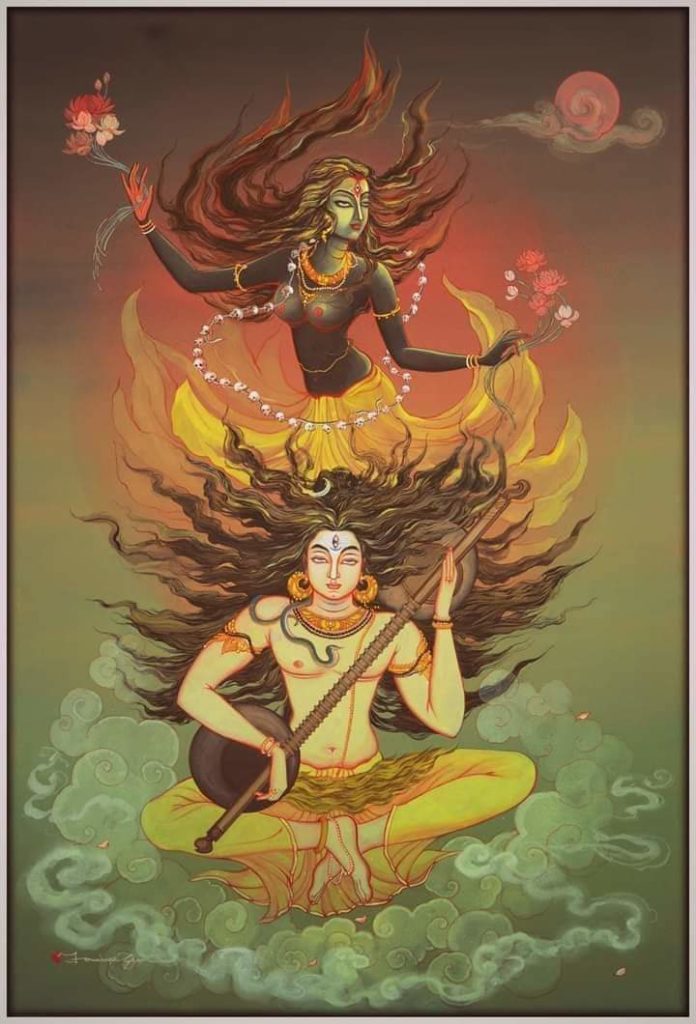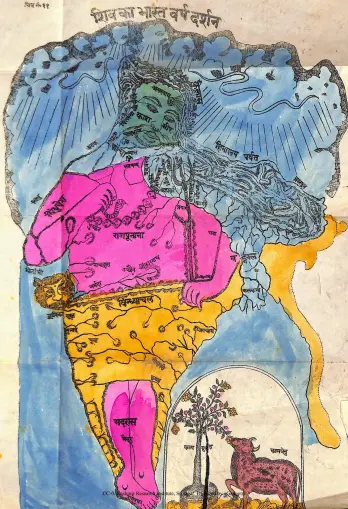Kashmiri Shaivism, a profound philosophical and spiritual tradition, stands as a unique and intricate system of thought, practice, and meditation that has been a part of Kashmir’s rich cultural and intellectual legacy for centuries. Rooted deeply in the Indian subcontinent, Kashmiri Shaivism presents an esoteric view of reality, divinity, and the self. It is not merely a religious sect but a metaphysical framework that seeks to answer fundamental questions about the nature of existence, consciousness, and the ultimate reality.

Table of Contents
The Essence of Kashmiri Shaivism
At its core, Kashmiri Shaivism revolves around the worship of Shiva, not as a distant or separate deity, but as the universal, all-encompassing reality. Shiva, in this system, is understood not as a singular god in the traditional sense, but as the Absolute – the source and essence of everything in existence. The tradition emphasizes that all of creation, including human beings, is an extension of this divine consciousness.
The key concept in Kashmiri Shaivism is the idea of Pratyabhijna (recognition). According to this philosophy, every individual’s true nature is divine, and realization of this divinity is the ultimate goal of human life. The practice of Kashmiri Shaivism aims to help practitioners recognize their own true nature as pure consciousness, a reflection of the Supreme Shiva. This recognition leads to liberation, or moksha, a state where the individual consciousness merges with the universal consciousness.
The Philosophical Foundations on Kashmiri Shaivism
Kashmiri Shaivism draws upon the principles of non-dualism (Advaita), but it also incorporates a distinct understanding of the relationship between the individual and the Divine. Unlike other non-dual traditions like Advaita Vedanta, which often stress the ultimate oneness and dissolve all distinctions. Spiritual and philosophical journey on Kashmiri Shaivism teaches that while everything is one at its core, the multiplicity of forms and experiences are real and meaningful. This is known as Spanda, or the divine vibration that pervades the universe. It recognizes the world of diversity as an expression of Shiva’s power and presence.
One of the central texts in this tradition is the Shiva Sutras, a collection of aphorisms that form the foundation of the philosophy and practice of Kashmiri Shaivism. The teachings in the Shiva Sutras describe the nature of the self, the universe, and the path to realization. The Tantras and Agamas, ancient scriptures that further elaborate on these concepts, provide the spiritual practices to achieve self-realization, such as meditation, ritual worship, and the chanting of mantras.
The Path of Meditation and Self-Realization
Meditation is at the heart of Kashmiri Shaivism. The practice of Dhyana (meditation) helps practitioners quiet the mind and connect with their inner divinity. The method used in Kashmiri Shaivism is not merely a form of relaxation or contemplation, but a conscious effort to reach an experience of Shiva-consciousness – a realization that everything, including oneself, is a manifestation of Shiva.

The tradition places heavy emphasis on anubhava, or direct experience, over intellectual understanding. This means that a practitioner doesn’t simply learn about the divine or philosophy from texts but seeks to experience it personally. Through intense self-discipline and inner devotion, one comes to experience the profound truth that the essence of the self is no different from the essence of the universe.
One of the most well-known meditation techniques in Kashmiri Shaivism is Kundalini awakening, which involves the rise of latent spiritual energy through the chakras. This process can lead to a transformative experience, culminating in the awakening of higher states of consciousness and ultimate union with the divine.
Key Figures in Kashmiri Shaivism
Throughout its history, Kashmiri Shaivism has been shaped and enriched by several great spiritual teachers and philosophers. Among the most influential figures are:
- Abhinavagupta: One of the most prominent figures in Kashmiri Shaivism, Abhinavagupta was an 11th-century philosopher, mystic, and poet. His works, such as the Tantraloka and Ishvara Pratyabhijna, are considered masterpieces that explain the metaphysical concepts of Kashmiri Shaivism. His teachings emphasize the practice of recognizing the divinity in all things and the liberation that comes from such realization.
- Ksemaraja: Another important figure in the tradition, Ksemaraja was a disciple of Abhinavagupta and made significant contributions to the philosophy of recognition (Pratyabhijna). His works elaborate on how the individual self can realize its inherent divinity through spiritual practices.
Kashmiri Shaivism and its Global Influence
Although Kashmiri Shaivism originated in Kashmir, its teachings have had a profound impact on various spiritual and philosophical traditions worldwide. Its non-dualistic nature resonates with many modern spiritual seekers, and its focus on personal experience over dogma appeals to those who wish to explore their own spiritual paths.
The tradition also shares common ground with other systems of thought, such as Zen Buddhism, Tantra, and even certain aspects of Western philosophy. This cross-cultural appeal has led to a growing interest in Kashmiri Shaivism in recent years, with more individuals turning to its teachings for deeper spiritual understanding and personal transformation.
The Relevance of Kashmiri Shaivism Today
In a modern world often defined by division, stress, and materialism, the teachings of Kashmiri Shaivism offer a timeless message of unity, inner peace, and transcendence. The philosophy’s emphasis on the interconnectedness of all things and the divinity within every individual provides a path to personal and collective healing.
By recognizing that everything in existence is an expression of divine consciousness, Kashmiri Shaivism calls on individuals to awaken to their own inherent divinity. This awakening not only leads to personal transformation but also fosters a deeper sense of compassion and unity in a fractured world.
Conclusion
Kashmiri Shaivism is a rich and complex spiritual tradition that offers profound insights into the nature of reality, consciousness, and the divine. Its unique approach to non-dualism, meditation, and self-realization provides a transformative path for those seeking to understand their true nature and attain a higher state of being. In a world where the search for meaning and purpose is ever-present, the timeless wisdom of Kashmiri Shaivism continues to inspire and guide spiritual seekers worldwide.
Kashmiri Shaivism: Frequently Asked Questions (Q&A)
Q1: What is Kashmiri Shaivism?
A1: Kashmiri Shaivism is a school of philosophy and spiritual practice that originated in the Kashmir Valley of India. It focuses on the worship of Shiva as the Supreme Consciousness and emphasizes the non-dual nature of reality. Unlike other traditions that view Shiva as a separate deity, Kashmiri Shaivism sees Shiva as the ultimate reality that pervades all of existence. The central idea is the recognition (Pratyabhijna) that one’s true self is identical with Shiva, the universal consciousness.
Q2: How is Kashmiri Shaivism different from other Shaiva traditions?
A2: Kashmiri Shaivism distinguishes itself from other Shaiva traditions primarily through its emphasis on non-duality (Advaita) and its focus on the recognition of the self’s divinity. Unlike traditions like Advaita Vedanta, which dissolves all distinctions to emphasize pure oneness, Kashmiri Shaivism recognizes the multiplicity of the world as an expression of the divine. The philosophy focuses more on personal direct experience (Anubhava) of divinity rather than intellectual study alone.
Q3: Who were the key figures in the development of Kashmiri Shaivism?
A3: The two most influential figures in the development of Kashmiri Shaivism are:
- Abhinavagupta (c. 950–1016 CE): A philosopher, mystic, and poet, Abhinavagupta is perhaps the most prominent figure in Kashmiri Shaivism. His works, like the Tantraloka and Ishvara Pratyabhijna, laid the foundation for much of the tradition’s philosophical and spiritual thought.
- Ksemaraja (c. 1000–1050 CE): A disciple of Abhinavagupta, Ksemaraja expanded on the idea of recognition (Pratyabhijna) and clarified how one can recognize their inherent divinity through practice and meditation.
Q4: What are the key texts in Kashmiri Shaivism?
A4: Some of the primary texts in Kashmiri Shaivism include:
- The Shiva Sutras: A collection of aphorisms that lay the philosophical groundwork of Kashmiri Shaivism, exploring concepts such as consciousness, the nature of the self, and liberation.
- The Tantraloka: Written by Abhinavagupta, this text serves as a comprehensive manual of Shaiva philosophy and practices.
- Ishvara Pratyabhijna: A treatise by Abhinavagupta, explaining the recognition of one’s true self as the ultimate consciousness, Shiva.
Q5: What is the practice of meditation in Kashmiri Shaivism like?
A5: Meditation in Kashmiri Shaivism is deeply focused on self-recognition, where the practitioner seeks to experience their essential divinity. The practice is not just about mental relaxation but about awakening to one’s true nature as pure consciousness. Techniques such as Dhyana (contemplative meditation) and the awakening of Kundalini energy are common. The goal is to experience the realization that one’s individual self is not separate from the divine, but is indeed an expression of Shiva.
Q6: What does ‘Pratyabhijna’ mean in Kashmiri Shaivism?
A6: Pratyabhijna translates to “recognition” or “re-cognition.” In the context of Kashmiri Shaivism, it refers to the practice of recognizing one’s true nature as Shiva, the Supreme Consciousness. It’s the idea that every individual’s essence is divine and that through proper practice, one can awaken to this realization, leading to liberation (moksha).
Q7: How does Kashmiri Shaivism view the world and its multiplicity?
A7: In Kashmiri Shaivism, the world is seen as a dynamic manifestation of the divine energy of Shiva. Unlike other traditions that may view the world as an illusion (Maya), Kashmiri Shaivism acknowledges the reality of the multiplicity of forms in the world while recognizing that they are all expressions of the one divine consciousness. This concept is known as Spanda, the divine vibration or pulsation that manifests as the entire universe.
Q8: Can someone from any background practice Kashmiri Shaivism?
A8: Yes, Kashmiri Shaivism is not limited to any particular religion or sect. It is a philosophical system that can be practiced by anyone interested in exploring their true nature and achieving self-realization. While the tradition has deep roots in Hinduism, its focus on non-duality and personal experience makes it relevant to seekers of all backgrounds, including those from other spiritual traditions or secular paths.
Q9: What is the role of the Guru in Kashmiri Shaivism?
A9: The Guru plays a central role in Kashmiri Shaivism, as spiritual guidance and mentorship are essential for progressing on the path to self-realization. A Guru helps the student navigate the complexities of the tradition’s teachings, meditation techniques, and practices. The Guru’s role is to inspire and assist the seeker in recognizing their true self through personal experience and spiritual discipline.
References
- Lakshmanjoo, Swami (2003). Kashmir Shaivism: The Secret Supreme. 1st Books Library. ISBN 1-58721-505-5.
- Muller-Ortega, Paul E. (2010). Triadic Heart of Siva: Kaula Tantricism of Abhinavagupta in the Non-Dual Shaivism of Kashmir. Suny press.
- Mishra, Kamalakar (1999). Kashmir Saivism, The Central Philosophy of Tantrism. Sri Satguru Publications. ISBN 81-7030-632-9.
- Muktananda, Swami (1980). Secret of the Siddhas. SYDA Foundation. ISBN 81-86693-07-6.
- Durgananda, Swami; Brooks; et al. (1997). Meditation Revolution. Agama Press. ISBN 0-9654096-1-9.
- Singh, Jaideva (2000). Śiva Sutras – The Yoga of Supreme Identity. Delhi: Moltilal Banarsidass. ISBN 81-208-0406-6.
- Singh, Jaideva (2005). Spanda-Kārikas – The Divine Creative Pulsation. Delhi: Moltilal Banarsidass. ISBN 81-208-0821-5.
- Singh, Jaideva (2008). Pratyãbhijñahṛdayam – The Secret of Self-Recognition. Delhi: Moltilal Banarsidass. ISBN 978-81-208-0323-7.
